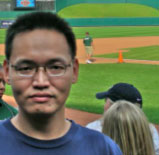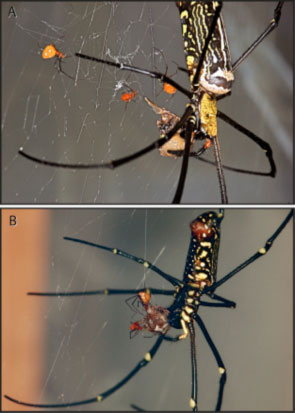We have moved to a new server!
Since March 2014, this website has been moved to this new server: http://web.ntnu.edu.tw/~treehopper/. This page will not be updated anymore. Please update your browser’s bookmark or the web links.
Member list
Current members
- Jo-Fan Wang
- 1. The Territorial Behavior of Euphaea formosa (Odonata). 2. Tempo and Mode of Pronotal Evolution in Membracis Treehoppers.
- Hung-Nien Chen
- 1. The effect of typhoon on survivalship of Matrona cyanoptera. 2. Modes of phenotypic variation in Euphaea amphicyana.
- Lan-Wai Yeh
- Ecology and evolution of Taiwanese Carabus ground beetles.
- Yun-Chieh Cheng
- What do damselfly larvae eat? DNA barcode analyses of larval diet in Matrona cyanoptera and Euphaea formosa.
- Chung-Hsin Huang
- Flucuating Asymmetry and Developmental Asymmetry of Cyclommatus mniszechi.
- Hui-Yun Tseng
- 1. Biological function of coloration in Pachyrrhynchus tobafolius. 2. Phylogeny and color evolution of Pachyrrhynchus weevils. 3. Population genetics of Pachyrrhynchus weevils on Lanyu and Green Island.
- I-Ting Hsiao
- Variation of genitalia in Euphaea amphicyana.
- Yen-Ting Chen
- The effect of forest management of Mt. Da-Shiue on the morphological variation of a ground beetle, Carabus (Apotomopterus) masuzoi.
- Jyun-Huei Huang
- The fighting behavior of a stag beetle, Rhaetulus crenatus.
- Shi-Ting Wu
- Membracis Phyllotropis.
- Chiao-Wei Lin
- The fighting behavior of a stag beetle, Rhaetulus crenatus.
- Yong-Chao Su
Past members
- Wei-Liang Xiao
- Variation of wing veins in Euphaea amphicyana.
- Li-Wen Weng
- Why do firefly larvae emit light?
- Yat-Hung Lee
- Speciation of Euphaea damselflies.
- Che-Yu Kuan
- Variation of mandibles in stag beetles.
- Chu-Yen Cheng
- Phylogeography of a Philippine's treehopper, Leptocentrus reponens.
- Ming-Yu Chen
- Phylogeography and population history of the treehoppers, Centrochares horifficus from the Philippines Archipelago.
- Shao-Chang Huang
- Visual Communication of Matrona cyanoptera
- Jen-Pan Huang
- Population Genetics and Phylogeographic Analyses of Formosan Damselfly, Euphaea Formosa (Insecta: Odonata: Euphaeidae) from Taiwan
- Wei-Yun Chen
- Molecular and Phylogenetic Characterization of Endosymbiotic Bacteria of the Froghopper, Okiscarta uchidae (Insecta: Hemiptera: Cercopidae)
Visiting scholars and students
- Vanitha Williams
- Predatory potential of waterbug, Diplonychus rusticus and dragonfly, Diplacodes trivialis on mosquito larvae.
- Marina Vilenica
- Dragonfly composition (Insecta, Odonata) in wetland area of Turopolje region, Croatia
- Klaas-Douwe 'KD' B. Dijkstra
- History, diversity and identification of dragonflies and damselflies (Odonata).
- Erin McCullough
- " Diversification of weapon form: aerodynamic costs of beetle horns.
- Ashley E. King
- Intrasexual combat and intersexual antagonistic co-evolution in horned beetles.
Yong-Chao Su

Title
Postdoc 2012
Species: Argyrodes miniaceus, A. miniaceus are stealing food from their host, Nephila pilipes, cooperatively.

Project
Behavioral ecology, sociobiology, population genetics, and molecular phylogenetics.
Abstrct
E-mail:ycsu527@gmail.com
Education
Ph.D. in Ecology and Evolutionary Biology, University of Kansas, USA
M.S. in Biology, Tunghai University, Taiwan
B.S. in Biology, Tunghai University, Taiwan.
Research summary
My dissertation was about the group-living behavior in kleptoparasitic Argyrodinae (Araneae: Theridiidae), and the species level molecular phylogenetic analysis of the Argyrodinae. I included four research approaches in this dissertation. I showed the first empirical study of cooperative kleptoparasitism in Argyrodinae. The results showed that, at least at the level of foraging, group-living behavior has adaptive function of cooperation. Using a game theory model, the payoff of being cooperator in a group is greater than the payoff of being solitary. Second, I found that kleptoparasites do not aggregate simply because the webs are large and can support multiple kleptoparasites. Social interactions among group members provide additional benefits that favor individuals remaining in groups. In the population genetic studies, I discovered that group members could gain indirect benefit of fitness by cooperating with group members, who are potentially related individuals. This is because in group-living Argyrodes, group members are significantly more closely related than the individuals drawn randomly from the population in a small geographic scale. The phylogenetic analyses showed several independent origins of group-living behavior in different species groups. The evolutionary sequence of foraging strategies of Argyrodinae is from free-living to araneophagy, then to kleptoparasitism. The comparative analyses showed the specialization to large host is correlated with the evolution of group-living behavior. In addition, the processes of specialization thus becoming group-living may have caused diversification within species groups.
The main project for my postdoc position in Dr. Lin’s lab is to develop methods for several phylogeographic projects for treehoppers and damselflies in SE Asia using both Sanger sequencing data and next generation sequencing data.
Publication
Su , Y. C., Chang, Y. H, Smith, D. R., Zhu, M. S., Kuntner, M., and Tso, I. M. 2011. Biogeography and speciation patterns of the golden orb spider genus Nephila (Araneae: Nephilidae) in Asia. Zoological Science 28(1): 47-55.
Cobbold, S. M., Su, Y. C. 2010. The host becomes dinner: possible use of Cyclosa as a nuptial gift by Argyrodes in a colonial web. Journal of Arachnology 38:132-134.
Su, Y. C., Chang, Y. H., Lee, S. C. and Tso, I. M. 2007. Phylogeography of the giant wood spider (Nephila pilipes, Araneae) from Asian–Australian regions. Journal of Biogeography 34: 177-191.
Lee, J. W., Jiang, L., Su, Y. C. and Tso, I. M. 2004. Is Central Mountain Ridge a geographic barrier to giant wood spider Nephila pilipes (Araneae, Tetragnathidae) in Taiwan? A population genetic approach. Zoological Studies 43(1): 112-122.